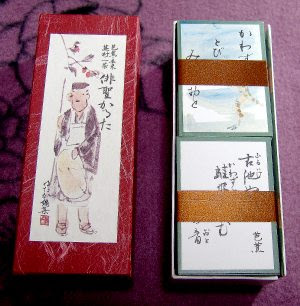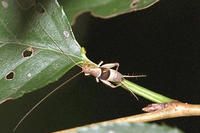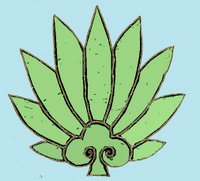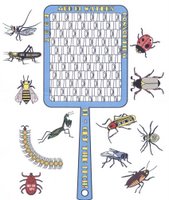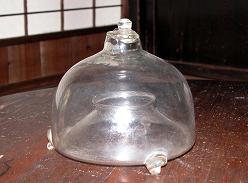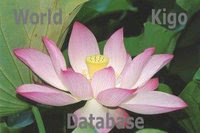. Inari 稲荷と伝説 Legends about the Fox Deity .
:::::::::::::::::::::::::::::::::::::::::::::::::::::::::::::::::::::::::::::::::::::::::::::::::::::::::::::::::::::::::::

Mr. Fox is on the watch!
:::::::::::::::::::::::::::::::::::::::::::::::::::::::::::::::::::::::::::::::::::::::::::::::::::::::::::::::::::::::::::
Fox Shrine Festival (Inari Matsuri)
***** Location: Japan
***** Season: Late Spring
***** Category: Observance
*****************************
Explanation
For other kigo related to INARI see below.
Inari 稲荷 the "Fox Deity", "Fox God". Inari's foxes, or kitsune, are pure white and act as their messengers.
quote
Inari Ōkami (稲荷大神, also Oinari)
is the Japanese kami of foxes, of fertility, rice, tea and Sake, of agriculture and industry, of general prosperity and worldly success, and one of the principal kami of Shinto. In earlier Japan, Inari was also the patron of swordsmiths and merchants. Represented as male, female, &/or androgynous, Inari is sometimes seen as a collective of three or five individual kami. Inari appears to have been worshipped since the founding of a shrine at Inari Mountain in 711 AD, although some scholars believe that worship started in the late 5th century.
- More in the WIKIPEDIA !
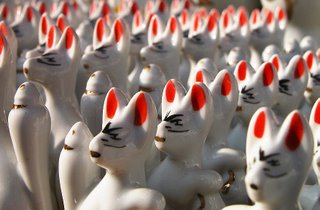
Fox God Festival, Inari Matsuri 稲荷祭 いなりまつり
visiting Fushimi Fox God Shrine Festival
... Inari Matsuri oide 稲荷祭御出、稲荷祭のお出
... Inari Shinkoosai 稲荷神幸祭, 還幸祭
Fox God Ceremony Group, Inari koo 稲荷講
visiting the Fox God Shrine for the first time,
Inari hatsumoode 稲初荷詣
This tradidional Japanese festival occurs on the first day of the horse according to the Asian lunar calendar.
The horse is the messenger of the Inari Deity.
. Inari fox on a horse .
There are many Fox Shrines in Japan and this is the first large festival of the New Year.
The great fox god shrine festival at Fushimi, Fushimi Inari in Kyoto is the most famous.
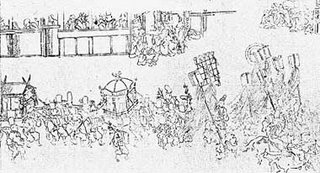
年中行事絵巻 稲荷祭(© 伏見稲荷大社蔵)
Click HERE to look at some photos !

Fushimi Inari Taisha Festivals 伏見稲荷大社
source : inari.jp

source : amamori.exblog.jp
Ukanomikami, Uka no Mikami 宇迦之御魂神 / 倉稲魂神
The deity for a good harvest, venerated at Inari shrines.
Miketsu Kami 御食津神 / 三狐神 "Three Foxes Deity"
Inari Kami 稲荷神 Deity to provide food
- quote
Ukanomitama
A kami of foodstuffs, thought to refer specifically to the spirit of rice. Kojiki describes the kami as the offspring of Susanoo, while Nihongi states that it was the offspring of the two kami Izanagi and Izanami. The Engishiki's comments on the Ōtono no hogai norito further identify the kami with Toyoukehime.
Ukanomitama is most commonly known as the kami Inari. From the medieval period, the kami was linked to popular combinatory kami such as Ugajin and Uka Benzaiten. Ukanomitama is enshrined at Kyoto's Fushimi Inari Taisha and other Inari shrines throughout Japan.
- source : Kadoya Atsushi, Kokugakuin 2005
:::::::::::::::::::::::::::::::::::::::::::::::::::::::::::::::::::::::::::::::::::::::::::::::::::::
quote
Fushimi Inari Taisha (伏見稲荷大社)
is the head shrine of Inari, located in Fushimi-ku, Kyoto, Japan. The shrine sits at the base of a mountain also named Inari, and includes trails up the mountain to many smaller shrines.
Since in early Japan Inari was seen as the patron of business, each of the Torii is donated by a Japanese business. First and foremost though, Inari is the god of rice.
Merchants and manufacturers worship Inari for wealth. Donated torii lining footpaths are part of the scenic view.
This popular shrine is said to have as many as 32,000 sub-shrines (bunsha (分社)) throughout Japan.
The shrine became the object of Imperial patronage during the early Heian period. In 965, Emperor Murakami ordered that Imperial messengers were sent to report important events to the guardian kami of Japan. These heihaku were initially presented to 16 shrines including the Inari Shrine.
The earliest structures were built in 711 on the Inariyama hill in southwestern Kyoto, but the shrine was re-located in 816 on the request of the monk Kūkai. The main shrine structure was built in 1499.
At the bottom of the hill are the main gate (楼門, rōmon, "tower gate") and the main shrine (御本殿, go-honden). Behind them, in the middle of the mountain, the inner shrine (奥宮, okumiya) is reachable by a path lined with thousands of torii.
Kodama-ike こだま池 (木霊池) is a pond where people come when a relative was lost. You clap your hands and listen carefully. The direction of the kodama (echo) tells you where to look for the lost person.
To the top of the mountain are tens of thousands of "honorable mounds" (御塚, o-tsuka) for private worship.
source : wikipedia
Yakuriki Sha 薬力社 Yakuriki Shrine
薬力大神
無病息災、薬効、薬害防止、安産、医学技術向上、健康長寿、家内安全、商売繁盛
(薬関係のお仕事、薬局、製薬会社等)
The deity in residence is a god for health and medicine, there are sub-shrines around the area of Yakuriki Shrine are also visited for a long life, advance in medical technology and treatment, success in medical operation and for other specific health related problems.
A deity for protecting the throat, 薬力大神 Yakuriki Ookami, is worshiped by people from performing arts such as singers and actors to perform daily on stage.
- reference -
. . . CLICK here for Photos !
:::::::::::::::::::::::::::::::::::::::::::::::::::::::::::::::::::::::::::::::::::::::::::::::::::::
- quote
On the way down are two "waterfalls,"
or rather places where water pours forth from an overhead trough so supplicants might stand beneath and test their faith while praying in the cold downpour, a religious austerity. The powerful Buddhist protector, Fudo Myo-o, is present in both spots.
- source : www.kyotoguide.com/ver2
. Fudō Myō-ō, Fudoo Myoo-Oo 不動明王 Fudo Myo-O
Acala Vidyârâja - Vidyaraja .
- Inari and Fudo 稲荷と不動明王 -
:::::::::::::::::::::::::::::::::::::::::::::::::::::::::::::::::::::::::::::::::::::::::::::::::::::

Another shrine which was founded by the immigrant clan Hata-uji (秦氏, Hata clan), Fushimi Inari Taisha (伏見稲荷大社).
In 711, Hata-no-Irogu (秦伊呂具), who is considered as the brother of Hata-no-imikitori (秦忌寸都理), established this shrine by enshrining the Inari deities at Mt. Inari (稲荷山) in Kyoto.
- Shared by Taisaku Nogi -
Joys of Japan, 2012
quote
The Hata clan (秦氏)
was an immigrant clan active in Japan since the Kofun period, according to the epic history Nihonshoki.
Hata is the Japanese reading of the Chinese (state and dynasty) name 秦 given to the Qin Dynasty (the real family name was Ying), and given to their descendants established in Japan. The Nihonshoki presents the Hata as a clan or house, and not as a tribe; also only the members of the head family had the right to use the name of Hata.
..... Members of this clan also served as financial advisors to the Yamato Court for several centuries. Originally landing and settling in Izumo and the San'yō region, the Hata eventually settled in the areas of what are now Japan's most major cities. They are said to have aided in the establishment of Heian-kyō (modern-day Kyoto), and of many Shinto shrines and Buddhist temples, including Fushimi Inari Taisha, Matsunoo Taisha, and Kōryū-ji.
© More in the WIKIPEDIA !
. The Hata Clan 秦氏 Hata Uji .
and the Korean and Christian connection
:::::::::::::::::::::::::::::::::::::::::::::::::::::::::::::::::::::::::::::::::::::::::::::::::::::
. Inari Myojin 稲荷明神 Honorable Inari Deity .
INARI refers to the Fox as the divine messenger and thus a deity himself.
KITSUNE refers to the fox as an animal. See below.
. Inari Daimyojin 稲荷大明神 .
and 小石川伝通院 Koishikawa Denzu-In, Dentsu-in, Tokyo
多久蔵主 (たくぞうす) Takuzosu. Also spelled 澤蔵主 / 澤蔵司 / 沢蔵
and the Inari fox priest Hakuzooshu 伯蔵主 Hakuzoshu / Hakuzosu
.................................................................................
Other New Year kigo for the
First Day of the Horse
in the second lunar month
. first day of the horse, hatsu uma, hatsu-uma 初午 .
horse festival, uma matsuri 午祭
first horse, ichi no uma 一の午
初午に狐の剃りし頭哉
. hatsu-uma ni kitsune no sorishi atama kana .
Matsuo Basho 松尾芭蕉
. hatsu-uma kyoogen 初午狂言(はつうまきょうげん)
Kyogen on the first day of the horse

source : blog.livedoor.jp/chino17jidai
taiko uri 太鼓売り vendor of drums
On the first day of the horse during the Inari festival, children walked around drumming, and since there were so many Inari shrines in Edo, the vendors made good business.
They sold all kinds of drums in various sizes and prices. They did not call out to announce their merchandise, but drummed on them, usually on the biggest one they carried, which was not for sale.
太鼓売り無言で歩きやかましさ
taiko uri mugon de aruki yakamashisa
the drum vendors
walk around not talking
but ever so noisy
. The Big Drum (taiko, oodaiko 大鼓、太鼓、大太鼓)and other drums .
. senryu, senryū 川柳 Senryu in Edo .
.................................................................................
Inari no bushasai 稲荷の奉射祭 (いなりのぶしゃさい)
first shooting at the Inari shrine
bushasai, busha sai 歩射祭(ぶしゃさい)
onyumihajimesai, on yumi hajime sai 御弓始祭(おんゆみはじめさい)
At Fushimi Inari on January 12.
With a special bow and arrow to ward off evil for the coming year.
Arrows are shot into the four directions to purify the place.
Finally the head priest shoots one big arrow.

source : sw21akira
hamayumi 破魔弓 bow to ward off evil
kamiya 神矢 "arrow of god"
. Hamaya, 破魔矢, arrow for the New Year .
Busha matsuri 歩射祭 or 奉射祭 - Introduction -
:::::::::::::::::::::::::::::::::::::::::::::::::::::::::::::::::::::::::::::::::::::::::::::::::::::

Inari 稲荷 <> The Fox Cult and Daruma
by Gabi Greve
Fushimi Fox God Shrine and Daruma
by Gabi Greve
ooo ooo ooo ooo ooo ooo ooo ooo ooo ooo ooo ooo
Inari is one of the most well known kami in popular folk Shinto. He (or she) is the god of rice and is related with general prosperity. In earlier Japan, Inari was also the patron of sword smiths and merchants. Primarily, however, Inari is associated with agriculture, protecting rice fields and giving the farmers an abundant harvest every year.
One of the main myths concerning Inari tells of this kami coming down a mountain every spring when it is planting season and ascending back up the mountain after the harvest for the winter. Both events are celebrated in popular folk festivals.
Read the details here and then come back :
INARI = Shinto Rice Kami
Mark Schumacher
Japanese Fox Belief 狐信仰 -
. Toyouke no Ookami 豊受大神
The Great Deity that gives Bountiful .
Deity of Rice and Food
. Myoobu Kitsune 命婦狐 Myobu fox court lady of the Heian period .
:::::::::::::::::::::::::::::::::::::::::::::::::::::::::::::::::::::::::::::::::::::::::::::::::::::
Toyokawa no Dakini Shinten 豊川のダキニ真天
She always appears riding on white fox.
. Dakiniten (Vajra Dakini) 荼枳尼天 .
:::::::::::::::::::::::::::::::::::::::::::::::::::::::::::::::::::::::::::::::::::::::::::::::::::::
The "voice" of the fox
霰こんこんこん触ル狐哉
arare kon kon kon fureru kitsune kana
going nuts in hailstones
crashing down...
a fox
Issa
Tr. David Lanoue
Onomatopoetic Words used in Haiku
Voice of an Animal and Haiku
Compiled by Larry Bole :
Translating Haiku Forum
In Japanese, a fox's bark is written, "Kitsu! Kitsu!"
This myth comes from a folk etymology of the word "kitsune," in which "kitsu" is onomatopoeia for a fox's bark and "ne" means "sound."
Therefore, a fox is something which makes the noise "kitsu." Whether this derivation of the word is true or not, it's been a long, long time since Japanese foxes said "kitsu." Modern Japanese write the fox bark as "kon kon."
http://academia.issendai.com/fox-misconceptions.shtml#bark
In English, the official words for foxes are "bark" and "yelp".
In Japanese it's simply "naku" なく 鳴く and the onomatopoeia is kon-kon こんこん
http://answers.yahoo.com/question/index?qid=20080604112441AAkjxob
Kitsune soba:
buckwheat noodles with fried tofu on top
きつねそば【狐蕎麦】

The fox is an indigenous, if not notorious creature in Japan. It is believed to have the power to bewitch or possess the spirit of anyone who looks into its eyes. The fox is also honored by business owners as a patron spirit animal. Stone images of foxes can be seen guarding almost every temple, great or small, in Japan. The golden bean curd omelet is called ABUR AGE (pronounced Ah-boo-rah-gay) and is often placed upon the altars of the temples as an offering to the gods who reside there.
Foxes are fond of aburage and are said to steal into the temples under the cover of darkness to whisk away the tasty fare left there for them. And thus, this bewitching bit of lore gives Kitsune
soba its name.
http://www.thingsasian.com/stories-photos/1488
My suggestion is to translate 'kon' as "yip:"
'kon kon kon' = "yip yip yip"
..............................................................................
According to Nozaki, the word kitsune was originally onomatopoeia. Kitsu represented a fox's yelp and came to be the general word for fox. -Ne signifies an affectionate mood, which Nozaki presents as further evidence of an established, non-imported tradition of benevolent foxes in Japanese folklore. Kitsu is now archaic; in modern Japanese, a fox's cry is transcribed as kon kon or gon gon.
© More in the WIKIPEDIA !
A famous childrens book in Japan
by Niimi Nankichi 新実南吉
His Memorial Museum in Handa town, Aichi
source : www.nankichi.gr.jp/sanpo

GON, the little fox
Gongitsune ごん狐, ごんぎつね
... More in the WIKIPEDIA !
My free translation of the above ISSA haiku
hailstones falling
kon kon kon
on Kon, the fox
Gabi Greve
*****************************
Worldwide use
*****************************
Things found on the way
. gankake torii 願掛け鳥居 miniature gate to make a wish .
Fushimi Inari Taisha Shrine 伏見稲荷大社
WASHOKU
Inarizushi, Inari Sushi いなりずし/ 稲荷寿司
. Sen Sotan Inari Jinja 宗旦稲荷神社 .
The tea master Sen Sotan and the Fox 宗旦狐 Sotangitsune, Sotan Kitsune
*****************************
HAIKU
spring rain--
showing a sake cup
calling foxes
harusame ya sakazuki misete kitsune yobu
春雨や盃見せて狐よぶ
by Issa, 1810
Tr. David Lanoue
http://cat.xula.edu/issa/
More Fox Haiku by Issa
*****************************
Related words
***** Oyama Fox God Festival
Inari Ooyama sai 稲荷大山祭
kigo for the New Year
shimehiki 注連曳き(しめひき)bringing sacred ropes
Inari shimehari 稲荷注連張(いなりしめはり) Inari sacred rope
shimehari shinji 注連張神事(しめはりしんじ)
kawarake hiroi 土器拾い(かわらけひろい)picking up ritual clay dishes
okawarake, o kawarake 御土器(おかわらけ)honorable clay dishes
On January 5
The sacred ropes along the stone wall are renewed.
At Fushimi Inari, Kyoto, on the Inari Yama 稲荷大山 mountain shrine.
In the valley below Gozendani 御膳谷 thre used to be two halls for the deities to feast : Miae dono 御饗殿 and O-Kama dono 御竈殿.
Food offerings were made on the sacred stone Mike ishi 御饌石 .
Now on the sacred stone 神石 70 small sacred clay dishes 斎土器 (imi doki) are placed, filled with ritual white sake (中汲酒 nakakumi sake) and prayers for a good harvest are offered.
Priests wear special ropes made from local vines (hikage no kazura 日陰のかずら) and a branch of sacred cedar.

CLICK for more photos !
The sacred dishes were auspicious amulets and people could take them home. The fight for getting one of the dishes was part of the festival, some people even got hurt in the wrangling.
The sacred dishes were a favorite of the local sake breweries, which took them as a sign for a good brewing season.
. Kawarake throwing at Mount Atago .
.................................................................................
***** Fox God Arrow Shooting Festival
Inari no Busha sai 稲荷の奉射祭
kigo for the New Year
At the Fushimi Fox God Shrine (Fushimi Inari) in Kyoto. To pray for good harvest and luck in the new year, arrows are shot in all directions to war off evel spririts and bad luck.
***** Inari Sushi (inarizushi いなり寿司)
kigo for summer
Food. Cold rice wrapped in a sheet of tofu.

***** . WKD : Horse (uma 馬) .
.................................................................................
kigo for late winter
. Ooji no kitsunebi 王子の狐火 (おうじのきつねび)
”fox fire" at Oji Inari Shrine .
.................................................................................
kigo for all winter
***** Fox (kitsune 狐)
Vulpes vulpes

akagitsune 赤狐(あかぎつね)red fox
kurogitsune 黒狐(くろぎつね)black fox
gingitsune 銀狐(ぎんぎつね)silver fox
shirogitsune 白狐(しろぎつね)white fox
juujigitsune, juuji gitsune 十字狐(じゅうじぎつね)
lit. "fox with the number ten", a pattern on its shoulder
. . . CLICK here for Photos !
kitakitsune 北狐(きたきつね)"northern fox"
Vulpes vulpes schrencki
hokkyoku gitsune 北極狐(ほっきょくぎつね)"polar fox" arctic fox
Alopex lagopus
Chishima gitsune 千島狐(ちしまぎつね)
fox from Chishima islands, Kuriles
kangitsune 寒狐(かんぎつね)fox in the cold
kitsunezuka 狐塚(きつねづか) fox den
Fuchsbau
kitsune wana 狐罠 (きつねわな) trap for fox hunting and more winter kigo
The Fox and the Badger (tanuki) are well known in Japanese legend as tricksters.
.................................................................................
Fox Haiku by Issa (Tr. David Lanoue)
Will-o'-the-wisp (kitsunebi 狐火 , onibi) Japan
:::::::::::::::::::::::::::::::::::::::::::::::::::::::::::::::::::::::::::::::::::::::::::::::::::::
. Yosa Buson 与謝蕪村 in Edo .
春の夜や 狐の誘ふ上童
. haru no yo ya kitsune no izanau ue warawa .
公達(きんだち)に狐化けたり宵の春
. kindachi ni kitsune baketari yoi no haru .
狐火や髑髏(どくろ)に雨のたまる夜に
. kitsunebi ya dokuro ni ame no tamaru yo ni .
kannagi ni kitsune koi suru yosamu kana
kitsunebi no moetsuku bakari kareobana
meshi nusumu kitsune oi utsu mugi no aki
suisen ni kitsune asobu ya yoizukiyo
草枯れて狐の飛脚通りけり
. kusa karete kitsune no hikyaku tori keri .
This is a hokku about a special famous fox from Tottori, called
Hikyakugitsune 飛脚狐 "the fast messenger "flying" fox"
He even has a Shrine in his honor.
- quote -
THE FOX BETWEEN TWO WORLDS
Withered grasses;
A fox messenger
hurries by.
That makes no sense in a Western context. To us — at least traditionally — a fox is a rather sly and clever animal. In traditional Japan, however, a fox (kitsune) is a creature that lives between two worlds — ours and the “spirit” world. In Japan, foxes were believed to be able to take on human form, and woe to the young man who happened to become infatuated with a fox spirit! He would just fade and waste away like a shoot of grass withering, and would eventually die.
Buson has reflected this notion in the withered grasses of the autumn fields in his hokku. He sees the fox hurrying past not as just an ordinary animal, but rather as a courier passing swiftly with a message to deliver, involved in his task and giving no attention to the human. Buson regards the foxes as living their own lives in their own eerie society, separate from that of humans, but occasionally coming in contact with them.
This verse has a feeling that we in the West would associate with Halloween. It is far from the best kind of hokku, but it did exist, and it does have its effect.
- source : Hokku David -
Withered grasses
where a fox messenger on flying legs
passed through.
Tr. Yuki Sawa & Edith Marcombe Shiffert
In withered grass
a fox carrying messages
passes by
Tr. Allan Persinger
:::::::::::::::::::::::::::::::::::::::::::::::::::::::::::::::::::::::::::::::::::::::::::::::::::::
. Basho Inari Jinja 芭蕉稲荷神社 .
Matsuo Basho Fox Shrine in Sumidagawa, Tokyo
. Fukushima Inari Jinja 福島稲荷神社
Fukushima Inari Shrine
. Handa Inari Shrine 半田稲荷神社 Tokyo .
. Inari 稲荷 the Fox Deity amulets . .
Tanuki, a badger posing as Daruma
. Inari 稲荷と伝説 Legends about the Fox Deity .
[ . BACK to WORLDKIGO . TOP . ]
[ . BACK to DARUMA MUSEUM TOP . ]
:::::::::::::::::::::::::::::::::::::::::::::::::::::::::::::::::::::::::::::::::::::::::::::::::::::








